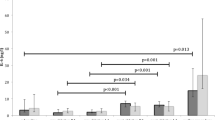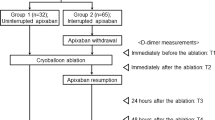Abstract
Cryoablation (CA) emerged as an alternative procedure to radiofrequency (RF). The aim of this study was to compare haemostatic system alterations in patients undergoing RF or CA for atrioventricular nodal reentrant tachycardia ablation. von Willebrand factor (vWF), spontaneous whole blood platelet aggregation, prothrombin fragment F1 + 2 (F1 + 2), thrombin-antithrombin complex (TAT), plasminogen activator inhibitor type-1 (PAI-1), and clot lysis time (CLT) were determined in 48 patients (27 CA; 21 RF; 19M/29F, mean age 49.6 ± 17.6 years). Blood samples were obtained before the procedure (T0), immediately after (T1), and 24 h later (T2). At T1 both procedures were associated with a significant increase in levels of the endothelial activation marker vWF. At T2 vWF levels were lower in CA than in RF group. No changes in whole blood platelet aggregation before and after ablation procedures were observed. At T1 both groups determined an increase in blood clotting activation markers, F1 + 2, TAT, and DD. At T2 F1 + 2, TAT and DD levels were similar to baseline values. The comparison between RF and CA showed no significant differences in F1 + 2 and TAT levels, whereas at T1 DD levels were higher in CA group than in RF group. Both procedures induced a significant decrease in CLT, whereas no changes in PAI-1 levels were found. There were no significant differences in CLT and PAI-1 levels. The fibrinolytic efficiency analysis showed that at T1 DD/TAT and DD/F1 + 2 ratios were lower in RF group and remained lower in RF than in CA group at T2. CA procedure may be associated with a lower degree of endothelial damage and with a higher fibrinolytic capacity respect to RF.


Similar content being viewed by others
References
Blomström-Lundqvist C, Scheinman MM, Aliot EM et al (2003) ACC/AHA/ESC guidelines for the management of patients with supraventricular arrhythmias - executive summary a report of the American college of cardiology/America heart association task force on practice guidelines and the European society of cardiology committee for practice guidelines (writing committee to develop guidelines for the management of patients with supraventricular arrhythmias) Developed in Collaboration with NASPE-Heart Rhythm Society. J Am Coll Cardiol 42:1493–1531
Lee DS, Dorian P, Downar A et al (2001) Thrombogenicity of radiofrequency ablation procedures: what factors influence thrombin generation? Europace 3:195–200
Parizek P, Haman L, Pleskot M et al (2011) Hemostatic changes before and during electrophysiologic study and radiofrequency catheter ablation. Int J Hematol 93:452–457
Jesel L, Morel O, Pynn S et al (2009) Radiofrequency catheter ablation of atrial flutter induces the release of platelet and leukocyte-derived procoagulant microparticles and a prothrombotic state. Pacing Clin Electrophysiol 32:193–200
vanOeveren W, Crijns HJ, Korteling BJ et al (1999) Blood damage, platelet and clotting activation during application of radiofrequency or cryoablation catheter: a comparative in vitro study. J Med Eng Technol 23:20–25
Frieman PL, Dubuc M, Green MS et al (2004) Catheter cryoablation of supraventricular tachycardia: results of the multicenter prospective “frosty” trial. Heart Rhythm 1:129–138
Khairy P, Chauvet P, Lehmann J et al (2003) Lower incidence of thrombus formation with cryoenergy versus radiofrequency catheter ablation. Circulation 107:2045–2050
Tse HF, Kwong YL, Lau CP (2005) Transvenous cryoablation reduces platelet activation during pulmonary vein ablation compared with radiofrequency energy in patients with atrial fibrillation. J Cardiovasc Electrophysiol 16:1064–1070
Michelucci A, Antonucci E, Conti AA et al (1999) Electrophysiologic procedures and activation of the hemostatic system. Am Heart J 138:128–132
Hannimen M, Yeung-Lai-Wah N, Gula L et al (2013) Cryoablation versus RF ablation for AVNRT: a meta-analysis and systematic review. J Cardiovasc Electrophysiol 24:1354–1360
Santangeli P, Proietti R, Di Biale L et al (2014) Cryoablation versus radiofrequency ablation of atrioventricular nodal reentrant tachycardia. J Cardiovasc Electrophysiol 39:111–119
Katristis DG, Josephson ME (2013) Classification of electrophysiological types of atrioventricular nodal re-entrant tachycardia: a reappraisal. Europace 15:1231–1240
Paniccia R, Antonucci E, Maggini N et al (2009) Assessment of platelet function on whole blood by multiple electrode aggregometry in high-risk patients with coronary artery disease receiving antiplatelet therapy. Am J Clin Path 131:834–842
Cellai AP, Lami D, Fedi S et al (2012) A hypercoagulable and hypofibrinolytic state is detectable by global methods in patients with retinal vein occlusion. Atherosclerosis 224:97–101
Watson T, Shantsila E, Lip GY (2009) Mechanisms of thrombogenesis in atrial fibrillation: Virchow’s triad revisited. Lancet 373(9658):155–166
Manolis AS, Melita-Manolis H, Vassilikos V et al (1996) Thrombogenicity of radiofrequency lesions: results with serial D-dimer determinations. J Am Coll Cardiol 28:1257–1261
Lisman T, de Groot PG, Meijers JC, Rosendaal FR (2005) Reduced plasma fibrinolytic potential is a risk factor for venous thrombosis. Blood 105:1102–1105
Semeraro F, Giordano P, Faienza MF et al (2012) Evidence that fibrinolytic changes in paediatric obesity translate into a hypofibrinolytic state: relative contribution of TAFI and PAI-1. Thromb Haemost 108:311–317
Scheer AJL, Shea SA (2014) Human circadian system causes a morning peak in prothrombotic plasminogen activator inhibitor-1 (PAI-1) independent of the sleep/wake cycle. Blood 123(4):590–593
Conflict of interest
None.
Author information
Authors and Affiliations
Corresponding author
Rights and permissions
About this article
Cite this article
Pieragnoli, P., Gori, A.M., Ricciardi, G. et al. Effects of cryoablation and radiofrequency ablation on endothelial and blood clotting activation. Intern Emerg Med 9, 853–860 (2014). https://doi.org/10.1007/s11739-014-1090-7
Received:
Accepted:
Published:
Issue Date:
DOI: https://doi.org/10.1007/s11739-014-1090-7




